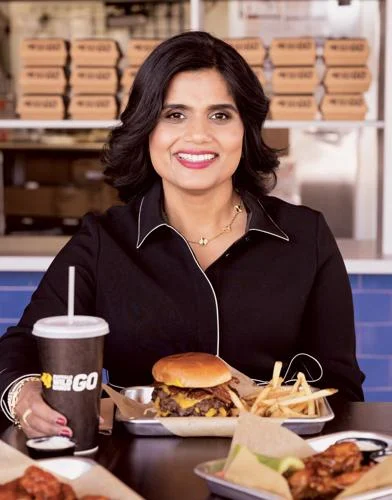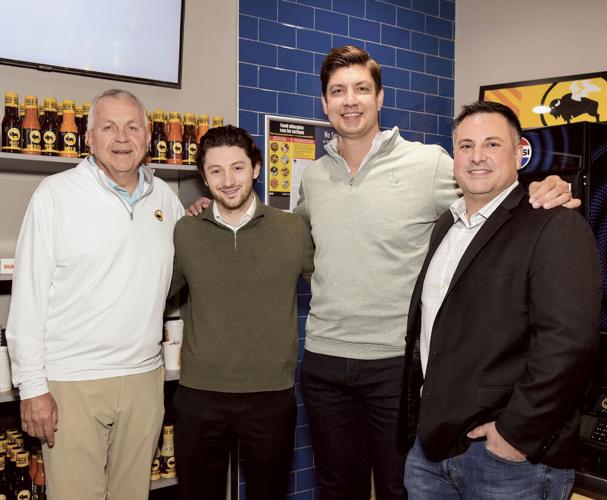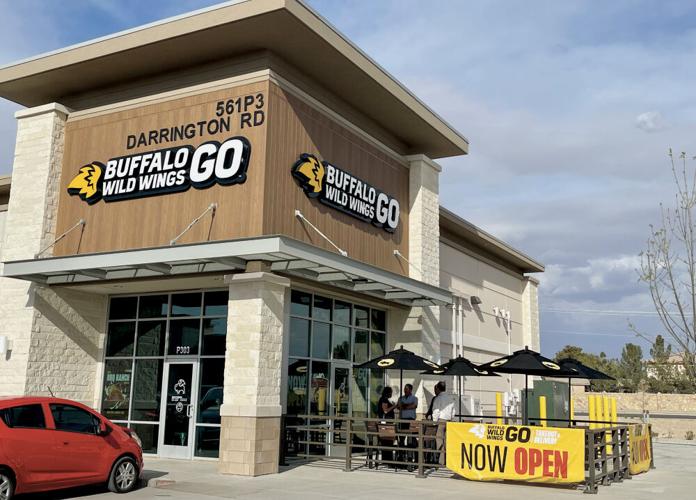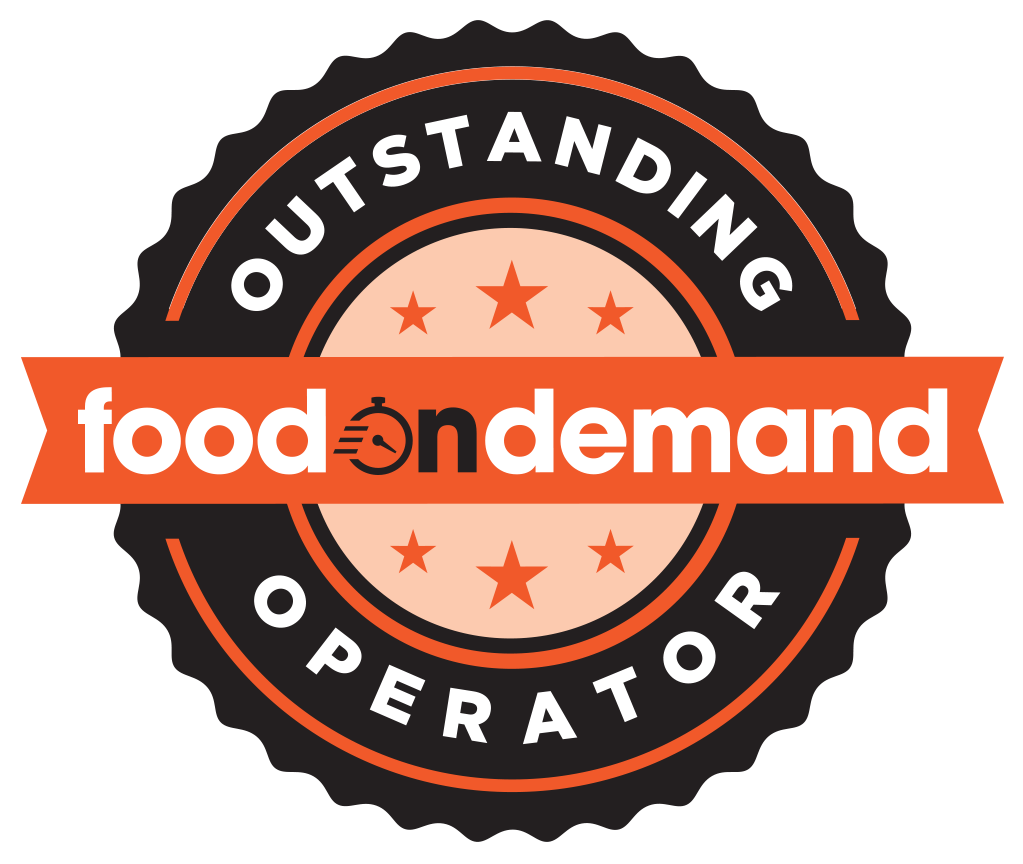Editor’s Note: This article originally appeared in Franchise Times—a sister publication to Food On Demand.
No wall-to-wall TV screens. No fans screaming in celebration (or groaning in dismay) for their favorite team. No alcohol in sight. And yet this Buffalo Wild Wings is churning out orders and Kajal Patel couldn’t be happier.
“I don’t want to deal with alcohol. Getting permits in Chicago, it’s like a nightmare,” she says. “That would create another hurdle, another challenge for us. And then also, to staff the store, to serve, that all becomes a challenge. We’re like, nope.”
Sitting inside the first Buffalo Wild Wings Go franchise in the Chicago area, Patel, CEO of The Hena Group, points out the various features of a restaurant geared entirely toward off-premises sales channels. There’s the order pickup display screens to clearly show each order status. A segmented pass-through window for kitchen staff to place food bags. And of course the condensed kitchen and slimmed down, delivery-friendly menu of chicken wings and tenders, burgers and a handful of sides.

Hena Group CEO Kajal Patel. (Photo by Mary Rafferty)
Patel’s BWW Go stores are averaging $1.5 million in sales, outperforming the system’s weekly average unit volume of $18,821 or roughly $978,692 per year. And that’s from a footprint of about 1,500 square feet. A standard Buffalo Wild Wings sports bar, meanwhile, does $3.5 million in sales out of restaurants ranging in size from 4,000 to 10,000 square feet.
“Off-premises, digital, chicken—it checked all our boxes when we were looking for a different brand,” says Patel, whose Hena Group is also a multi-unit Dunkin’ operator.
Those are the exact boxes Inspire Brands had in mind when it developed the Go model five years ago. Already more than 170 units strong, BWW Go is proving itself a compelling option for franchisees in search of a model with lower buildout costs, fewer operational complications and, at least so far, strong sales.
‘A brand equity leverage play’
When Arby’s Restaurant Group bought Buffalo Wild Wings in 2018 and renamed itself Inspire Brands, the sports bar chain was already working to grow the B-Dubs Express concept it piloted the year before. At 2,500 square feet and 35 to 50 seats, it was a counter-service model that still sought to offer a sports bar environment with TVs and alcohol.
Inspire Brands, though, stopped development after three units and “B-Dubs Express met its end,” says John Bowie, Buffalo Wild Wings brand president.
“We always thought there would be a market for a much smaller footprint, a takeout and delivery type business,” he continues. “We didn’t think at the time that was it.”
Then consumers began embracing third-party delivery, a shift further accelerated by the coronavirus pandemic and there’s no turning back. Within the Buffalo Wild Wings business, off-premises chicken wing sales were on the rise, and as leaders rethought a smaller footprint offshoot, they adjusted heavily in favor of a digital-forward model.

From left to right, Buffalo Wild Wings Brand President John Bowie, franchisee Jack Litman, BWW Chief Marketing Officer Tristan Meline and BWW Go Brand Head Tony Rothrauff.
The first BWW Go store, an 1,800-square-foot unit, opened near Inspire Brands’ Atlanta headquarters in May 2020. The company built about 30 of them in various markets and experimented with real estate and proximity to its full-service Buffalo Wild Wings restaurants before it began a heavier franchise push.
“Let’s encroach on our own company-owned sports bars,” says Bowie of the initial development approach. “Let’s take all the risk on ourselves before we open this up to franchisees. And let’s learn as much as we possibly can so we can be the best possible franchisor to them.”
The takeout chicken wing business is predominately driven by weeknight and weekend sales, the company confirmed as it operated those units, with consumers ordering from restaurants not near where they work but near where they live. That informed a location strategy focused on residential versus commercial population centers.
The company found the Go units were most successful as inline or endcap spaces near residential areas with a high daytime population. “It’s not places where you traditionally put a sports bar in, but certainly the exact appropriate place to put a takeout business,” says Bowie.
Tony Rothrauff, brand head for BWW Go, notes other adjustments came in the form of an enhanced wing cooking process that reduces waste and yields faster ticket times, and refinement of the labor model. Go units operate with five or six people during peak periods, while a Buffalo Wild Wings sports bar typically needs 40 to 60 employees.
BWW Go is very much “a brand equity leverage play,” says Bowie, as it benefits from the awareness generated by more than 1,100 Buffalo Wild Wings restaurants. Just over half are corporate outlets. There’s plenty of white space for Go units, he stresses, which are recognizable as Buffalo Wild Wings and unmistakable in their off-premises focus.
Bold “GO” signage with the takeout and delivery message front and center eliminates any consumer confusion about the restaurant experience. Search for “BWW Go” online and you’ll see this descriptor: “Wings for delivery and takeout.”
Traditional Buffalo Wild Wings locations have since rebranded their pickup areas with the same “Go” look. That’s led to a “significant lift” in the off-premises business for the sports bars, says Bowie—those channels account for more than one-third of sales—and it’s helped the company maximize its media budget.
“By branding our off-premises in the sports bars as ‘Go’ and helping that business, we’re enabled to go out to market with a fairly significant media spend right out of the gate and talk about all the things you can get from Buffalo Wild Wings Go, which is inclusive of both of those business channels,” says Bowie.
While the number of traditional Buffalo Wild Wings units has remained largely unchanged over the past three years, the company is “as
committed as ever” to growing with the sports bar format, notes Bowie. It is slated to open more than 10 locations this year.
‘Where the future is’
Existing franchisees within Inspire Brands are largely responsible for the growth of BWW Go thus far. About 85 percent of the Go model franchisees operate another concept under the Inspire umbrella, be it Dunkin’, Sonic Drive-In, Jimmy John’s or Arby’s, says Rothrauff.
“But word of mouth traveled, and we’ve got a tremendous amount of non-Inspire franchisees that have come into the network,” he says. “One, they see the power of Inspire, and they want to be part of that, and then they also see the growth and the potential of Buffalo Wild Wings Go.”
Kajal Patel signed up to open 10 BWW Go locations in the Chicago metro. The first debuted in November 2023 in Merrionette Park, Illinois, in a strip center endcap that once housed a GameStop store. She’s since opened two more and says the off-premises model is “where the future is.”
Patel’s quick-service roots run deep. Her father, Govind Patel, was a partner in some Dunkin’ stores—“We grew up sleeping on those donut bags back in the day,” she says—and about 20 years ago she formed The Hena Group after acquiring four Dunkin’ units. In addition to BWW Go, Hena Group has grown to 45 Dunkin’ stores, including several Dunkin’/Baskin-Robbins combos, with three more in development. Her husband, Bhavesh Patel, oversees development and brother Sam Patel is the group’s chief financial officer.
As she began evaluating opportunities to branch out beyond Dunkin’, Patel zeroed in on the chicken segment. “Chicken is on fire,” she says, and they first looked into Wingstop but the territory she wanted near her coffee operations was already sold. In considering a handful of emerging franchises in the space, and there are dozens, their unproven nature gave her pause.
“The other brands were too new,” she says. “You kind of question, what happens if it doesn’t make it?”
BWW Go is new, too, she notes quickly, but it has the backing of Inspire Brands and the brand awareness of Buffalo Wild Wings. “We didn’t have to educate people on what B-Dubs Go is,” she says. “The brand awareness, the brand affinity was there.”
When Inspire acquired Dunkin’ Brands in late 2020, “we were all like, what’s next?” recalls Patel. But then leaders such as Kate Jaspon, who was the CFO of Dunkin’ Brands and took the same role at Inspire, and Jason Maceda, now Inspire’s chief development officer, moved to the new parent company. Confidence in that leadership, says Patel, was a difference maker in choosing BWW Go.
“I think business is one piece, but being able to connect with people is so important because we’re in the people business,” she says. “With Kate, she has always empowered her franchisees. She has always stood behind and encouraged us.
“When you get that from an executive, you know they’re watching your bottom line. They’re out there making sure that your business model is successful.”
Patel’s BWW Go restaurants see a solid lunch business but sales trend heavily to the dinner daypart. Professional and college sports seasons definitely impact the volume—the Super Bowl and March Madness were huge—and Patel says local marketing in the form of building relationships with area colleges and high schools is important.
As is visibility on the major third-party delivery platforms.
Neeraj Ahluwalia opened his fourth BWW Go in March, in the Queens market of New York, and says he runs his own promotions on DoorDash, Uber Eats and Grubhub, spending beyond the marketing dollars the brand puts into those channels. Paid social media campaigns are also effective.
“My team and I, we look at competitors to see what offers they have on those apps and then we counter them, we make up our own lunch specials or happy hours,” he says. “A lot of consumers, they want a value deal.”
Buffalo Wild Wings, meanwhile, runs BWW Go menu exclusives, such as its Golden Fire sauce or $19.99 wing bundles.

Franchisee Neeraj Ahluwalia operates four Buffalo Wild Wings Go restaurants.
Ahluwalia, who like Patel is also a multi-unit Dunkin’ and Baskin-Robbins franchisee, says the proximity of his restaurants to schools and hospitals helps draw a good lunch business, while the “main core” is 5:30 p.m. through late night. His locations are open until 1 or 2 a.m. and digital orders for pickup or delivery account for 70 percent of sales.
With “extremely” high rents in his area, Ahluwalia says the smaller, adaptable footprint of BWW Go affords him some flexibility in finding real estate. He typically looks for 1,600-square-foot spaces, but one of his restaurants is just 850 square feet with a delivery pickup window.
Ahluwalia credits Rothrauff and the brand’s development and construction teams for working with franchisees to reduce costs. A new prototype has roughly $100,000 in cost savings, he notes, with less expensive lighting and even more efficient equipment. The purchasing power of Inspire, which with all its brands encompasses 30,000-plus global units, is a major advantage, he adds.
Inspire, agrees Jack Litman, does whatever it can to drive costs down, which is crucial for the multi-unit, multi-brand franchisee who has 35 units across the parent company’s brands. Especially with “this crazy inflationary environment,” saving $6,000 by going with wallpaper instead of tile or another $5,000 by putting the Pepsi machine on the same counter as the point-of-sale terminal versus its own piece of millwork makes a difference in the return-on-investment timeline.
Litman is president of The Munson Group, which entered Inspire Brands in February 2021 when it bought seven Sonics in southern New Jersey and eastern Pennsylvania. It purchased several Buffalo Wild Wings sports bars in Central Jersey in 2022 and now has 18 to go along with the seven BWW Go units it opened. The group committed to developing 30 Go restaurants across South Jersey, Philadelphia, Manhattan, Nassau County and up to southern Connecticut.
Buildout costs have been between $500,000 and $650,000 for each store, says Litman, who was attracted to the Go model for that lower price tag and the smaller footprint. The standard sports bar model costs upwards of $2.4 million.
“We took Manhattan as our first flagpole, and it was awesome to enter a market where rent’s extremely expensive,” he says. “We’re able to streamline our operations and still deliver the amazing Buffalo Wild Wings product, but we’re able to do so profitably and with a lot less risk than taking 7,000 square feet in Times Square, which would be an astronomical rent compared to 1,200 square feet.”
The price per square foot of the group’s Go restaurants in Manhattan is $80 to $135.
Litman is encouraged by the strong openings thus far, with lines wrapped around the block in some cases as people seek to be among the first 100 customers and secure weekly free wings for a year. Like Patel, Litman says he doesn’t miss the alcohol offering because liquor licenses are “extremely expensive” in his markets, if they’re even available.
Two non-traditional BWW Go units serve alcohol, and the company said it’s possible more non-trad locations will have beer and wine.
“We’re performing really well across our portfolio,” says Litman. “We’re pretty happy with where we are. They’re continually optimizing the operation model, which has allowed us to take some labor hours out of our boxes, which has been awesome.”
The Munson Group last summer opened a new Sonic-BWW Go co-located outlet in West Berlin, New Jersey, and Litman says the company is looking at more opportunities to add the Go concept to existing operations. Some of its Sonics have dining rooms that could be modified to become Go units, he notes, and they’re discovering synergies between the two brands that may drive sales as a Sonic customer coming for one of that brand’s inventive slushies could easily pick up wings during the same stop.
Back in Chicago, Patel and The Hena Group are working to open a multi-brand location featuring Dunkin’, Baskin-Robbins, Jimmy John’s and BWW Go. The co-branding options, says Patel, unlock even more opportunity under Inspire Brands. And she, for one, is ready to go.


